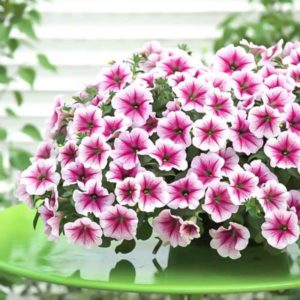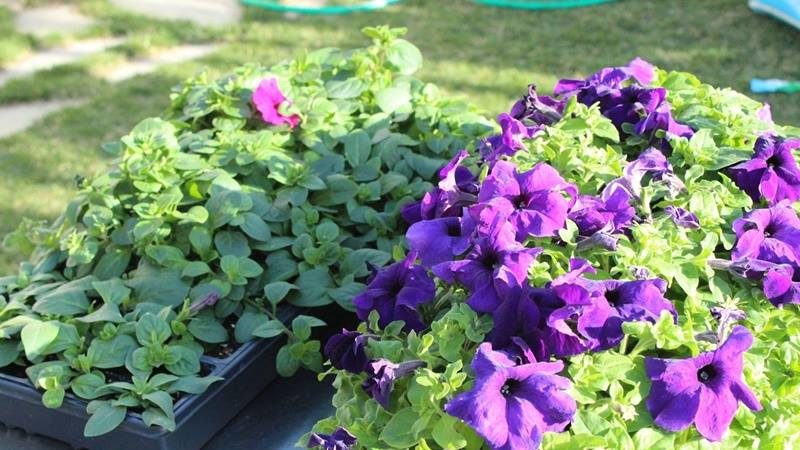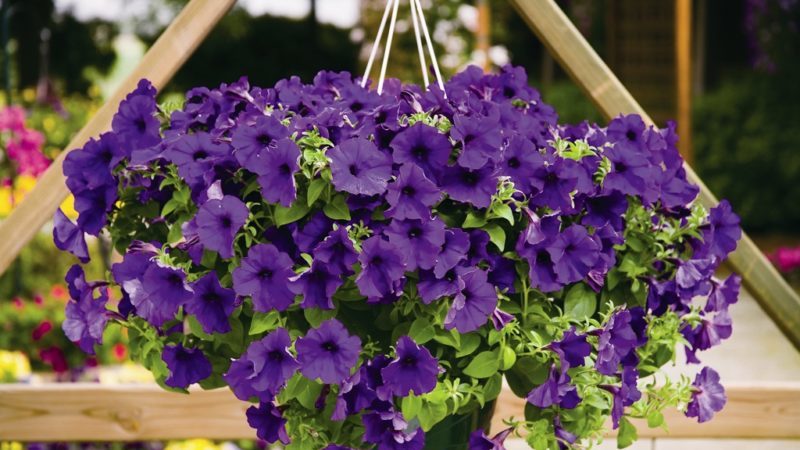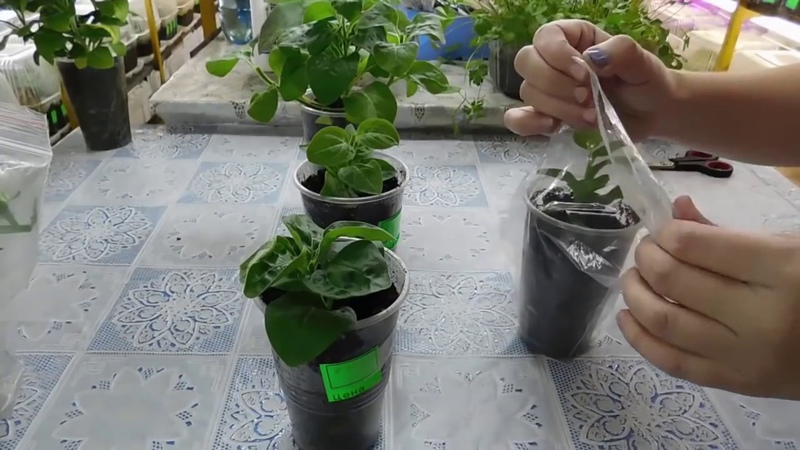Features of cascading petunias and their advantages over other species
Petunia is considered one of the most popular ornamental cultivated plants. It is distinguished by abundant and long flowering, unpretentious care, ease of reproduction. Petunia fits perfectly into landscape design and harmoniously coexists with other plants.
The appearance of this plant depends on the variety. There are ampelous, bush, double and cascade varieties on the market. Particularly popular is the cascade petunia, which looks beautiful not only in flower beds, but also in hanging flowerpots. How do cascading plants differ from ampelous and other varieties - read on.
The content of the article
Plant characteristics and description

Cascade petunia - variety ampelous... It differs from other types of this culture in the form of shoots. In the process of growth, they go first up and then down, falling in a cascade. At the same time, the plant is strewn with a large number of flowers, which is why its top has a spherical shape.
Plant characteristics:
- Leaves. They are oval-rounded and have pointed tips on both sides. The maximum length of the leaf plate is 5 cm. The color is deep green, pubescence is present.
- Shoots. Thick, powerful, durable. The maximum diameter reaches 2 cm. The length varies between 1.5-2 m. At the base, the shoots grow up, then diverge to the sides and fall down. They do not break even in strong gusts of wind.
- Flowers. The bush is densely covered with them. The flowers are large, 5-7 cm in diameter. The color of the flowers does not differ on the lateral and main branches of the same plant.
- Bush shape... Spherical with shoots diverging in different directions or falling downwards.
- Best growing place... Cascading varieties look good in floor and hanging planters. They are used to fill alpine slides. For cascading petunias, it is recommended to choose hills, rather than flat areas.
Another variety of petunias is super cascading. In such plants, the lashes are more powerful, but shorter than in ordinary cascading ones. The plant is distinguished by large flowers (diameter about 12 cm), multi-flowering and long flowering. Recommended for planting in flowerpots, floor and hanging pots.
Cascading petunias were bred in the middle of the 19th century. For this, the method of cell hybridization was used. The plant quickly won the hearts of flower growers due to its abundant flowering and aesthetic shape of the bush. It is grown everywhere because of its high resistance to adverse environmental factors.
Petunia is a perennial plant but in our country it is often grown as an annual. After all, the plant is not able to survive in the open field the harsh winters. You can save the bush by arranging for it the correct wintering at home.
It is interesting! There are annual varieties of the described culture.
Cascading petunia is not a capricious plant. Despite this, it is more whimsical than upright bush varieties. Varieties with long lashes need proper, fairly frequent watering, protection from diseases and pests, and ensuring full air exchange between shoots.
Differences from other types of petunias

Cascade petunia is easy to distinguish from bush. Shoots of bush forms grow up or to the sides, do not hang down.Their whips are quite short, but powerful. It is the bush varieties that are considered the most unpretentious and hardy. There are variants with small simple flowers and large double flowers.
Ampel varieties are often confused with cascading. Consider the difference between cascading and ampelous petunias:
- Leaves. Ampel petunia has larger leaves. Their diameter reaches 10 cm. The shape does not differ from the cascade variety.
- Shoots. In the ampelous culture, they are less powerful, but rather strong and flexible. The length reaches 2 m. They grow downward.
- Flowers. Flowers on the same bush often differ in color and size.
- Bush shape. In this case, the base of the bush does not resemble a ball, but looks rather flat. This is due to the fact that the shoots begin to fall down from the very base.
- The best landing spot. Ampel petunia is not used to decorate flower beds. It looks best in hanging pots.
The advantages and disadvantages of this type of petunia

Cascading petunia is popular with gardeners. This is due to an extensive list of its advantages:
- Endurance. Easily adapts to negative environmental factors. It can grow even in cold regions of our country. It tolerates temporary frosts.
- Unpretentiousness. Caring for petunia is easy. The plant needs regular watering and rare dressing, but does not die if the gardener did not look after him.
- Long bloom. The cascade variety pleases with its flowering from May to the onset of frost.
- Abundant flowering. The plant produces a large number of fairly large flowers at the same time.
- Attractive appearance. Due to the fact that the shoots do not immediately fall down, but first grow up, the bush has a beautiful shape and looks attractive even at the base.
- Versatility. Cascading culture looks equally good in hanging and floor pots, in flower beds. It is considered an ideal option for decorating alpine slides.
Cascading varieties also have disadvantages:
- Cascading varieties require more frequent watering than bush varieties.
- Due to the fact that the lashes of petunias growing on a flower bed touch the ground, the likelihood of infection increases.
- Cascading varieties require more free space than bush varieties.
The best varieties of cascading petunias
There are many varieties of cascading petunias. They vary in color and size of buds, length of stems, shape and some other characteristics. The most popular varieties are presented in the list:
- Double cascade... The main feature is huge double flowers. The color of the greenery is emerald. Has a pronounced aroma.
- Ramblin. At the base, the shoots rise 40 cm, while their length reaches 1 m. Such parameters allow you to create original compositions with the help of a plant. The advantage is considered earlier flowering and a large number of buds. Flowers from this group come in a variety of colors. Ramblin Amethyst is especially popular. The variety lives up to its name with purple and lilac flowers.
- Blue waterfall... The variety can be distinguished by its large blue flowers that resemble a carnation. The advantages include resistance to unfavorable environmental factors, undemanding care.
- Waterfall Pink soft... An annual hybrid with double flowers. The plant grows well, quickly throws out shoots. Forms large buds.
- Cascading Snow White. Petunia with very large white flowers. Differs in long flowering.
Growing technology
Regardless of the type of technology cultivation cascading petunia is the same. The culture is considered unpretentious, but requires minimal maintenance. The main thing is to plant it correctly.

Optimal conditions
Petunia is hardy, but when optimal conditions are created, it will bloom more abundantly and throw out longer shoots:
- Temperature. The plant feels best at a temperature of + 15 ... + 26 ° С. Moreover, it is able to tolerate frosts down to -10 ° C.Poorly tolerates heat (+ 40 ° C). In this case, burns on the leaves may occur.
- Humidity. Requires regular watering. It can tolerate short-term droughts or waterlogging of the soil. When moisture stagnates, it starts to hurt.
- Shine. The plant is light-loving. In the shade, it throws out a large amount of greenery, but sets few buds.
- Weather... Shoots can be damaged in strong wind or heavy rain. To avoid this, planting in pots during bad weather cleaned under a canopy.
Pot and soil requirements
Most often, petunias are grown in pots outside or on the balcony.... In this case, it is important to choose a good container so that the plant has enough space.
Only one adult plant will fit in a 5 liter pot. Up to two plants are planted in a ten-liter planter. A container with a volume of 10 l to 15 l can hold no more than three plants, provided that the container is wide enough.
It is not necessary to choose deep pots for petunias. The main thing is that they are wide enough.
Note! Terry varieties require more free space than regular varieties.
The pot material does not matter. Plastic containers are usually chosen as they are lighter and cheaper. Ceramic pots prevent the soil from drying out or moisture stagnation due to the ability to absorb excess liquid into the walls and give it away. However, they have a higher price and weight.
It is important that there are holes in the bottom of the planting container. They will prevent stagnant fluid.
Petunias prefer sandy loam and loamy soils, but they also grow in black soil. It is important to ensure the neutral acidity of the soil.
When preparing open ground, the soil is dug up in the fall, cleaned of plant residues, humus (5 kg per 1 sq. M), dry lime or ash (if acidity is increased), superphosphate (30 g per 1 sq. M) are added. Fertilizers are mixed with soil.
When grown in a pot, the following components are taken to prepare the earth:
- 2 pieces of turf;
- 2 parts of sheet soil;
- 1 part peat;
- 1 part humus.
Drainage is also used. It is poured into the bottom of the pot.
The soil, containers and drainage are disinfected. To do this, use a solution of copper sulfate (1 tbsp. L per 10 liters of boiling water) or a dark pink solution of potassium permanganate.
Terms and rules of landing

You can buy ready-made petunia seedlings on the market. Some gardeners grow it from seeds or shoots on their own. Usually, by the time of planting, the plant already has blossomed buds.
Petunias are planted in open ground or flowerpots on the street in early May. Dig holes in the ground equal to the volume of containers in which the seedlings were located.
Seedlings are removed from the pots along with a lump of earth, after watering and allowing the liquid to absorb. It is transplanted into the holes, the free space is covered with soil, without deepening the root collar. The soil around the plants is compacted and watered abundantly.
In the open field, plants are planted at a distance of 12-15 cm from each other. It is recommended to plant several plants in a flowerpot so that the composition looks more magnificent.
Further care

Petunias require minimal maintenance. The list contains basic rules:
- Pruning. It is not necessary to pinch a cascade petunia. However, in order to stimulate the formation of new lashes and make the bush more lush, some gardeners pinch immediately after the formation of the sixth leaf. To renew bloom and to make it more abundant, pick off withered buds and seed pods.
- Watering. On hot days, petunia is watered daily. In cool weather, two waterings per week are enough. On average, 7 liters of water are consumed per plant. Water is poured into the planter until it starts flowing out of the drainage holes.
- Top dressing. Fertilizers are applied twice a month. Mineral (containing phosphorus, potassium, magnesium) and organic (chicken droppings, humus, mullein) alternate.
- Loosening and weeding. After each watering or rainfall, the soil is loosened to destroy the earth crust, which prevents normal air exchange. In the process of loosening, weeds are removed from the flower bed.
Possible problems
Sometimes petunia is affected by diseases and pests. The following problems are considered the most common:
- Aphid. Colonies of small black, brown or green insects appear on the shoots and the seamy side of the leaves. The problem is accompanied by the appearance of sticky spots and curling leaves. To destroy pests, flowers are sprayed with soapy water (300 g of soap per 10 liters of water), pepper infusion (1 kg of pods of red hot pepper is ground and poured into 10 liters of water, infused for 10 days, then 100 g of the resulting concentrate is diluted in 10 liters of water with 40 g soap and used for spraying).
- Spider mite. It can be found by the cobweb on the seamy side of the leaves. The pest feeds on the sap of the plant, leading to its wilting. They fight the tick as well as the aphid.
- Powdery mildew... White spots appear on the plant. Over time, they turn brown. Dry spots appear on the affected areas, the leaves fall off. To cope with the disease use fungicides ("Quadris", "Fundazol") or a solution of iodine with milk.
Reproduction methods
Petunia is propagated in two ways - vegetative and generative. In the first case, shoots are used, and in the second, seeds.

Seed reproduction
Seeds are sown in February or early May... Usually already processed planting material is sold. Self-collected bones must first be soaked for half an hour in a light pink solution of potassium permanganate, and then for 12-24 hours with a growth stimulator (in "Epin", "Solution").
The seeds are sown in a common container or in peat tablets. The difference between these methods lies in the fact that in the first case you will have to dive the plants into individual containers, and in the second not.
Seedling growing rules:
- The container is filled with drainage, soil and watered. Seeds are sown into grooves 1 cm deep at a distance of 5 cm from each other. They are sprinkled with soil and sprayed with a growth stimulator solution.
- The container with the crops is covered with foil and placed on the windowsill. For cultivation, room temperature is used.
- The soil is moistened as it dries from the spray bottle. The crops are ventilated daily for 15 minutes.
- When shoots appear, the airing time is increased. Then the greenhouse is dismantled.
- To stimulate growth, the seedlings are sprayed with Epin's solution or a light pink solution of potassium permanganate.
- After the appearance of three real leaves, the seedlings dive into individual pots (disposable plastic cups are suitable).
- Petunia can be transplanted into a large pot after six leaves appear.
Vegetative propagation
Petunia shoots can be asked from neighbors or cut from the mother plant dug out and transferred to the house last year. Root cuttings as follows:
- Cuttings 10 cm long are cut from petunias. They are cleaned of all leaves except the top two.
- The cuttings are dipped into a root formation stimulator ("Solution") for a day with the cut point in them. Then the cut is dipped into ash.
- The cuttings are planted in sand, which is watered with water at room temperature. The container is covered with foil or glass.
- When the plant takes root and starts throwing out new leaves, it is transplanted into a pot of soil.
How and when to harvest seeds correctly
Petunia seeds are harvested from early June until the end of flowering. Planting material is formed in fruits - bivalve capsules that open when ripe.
Terry varieties do not form seeds. To obtain planting material from double flowers, pollen is collected and transferred to ordinary inflorescences. The resulting fruits on an ordinary petunia pollinated in this way will contain seeds of terry plants.
Conclusion
Cascading petunia is one of the varieties of the garden flower popular all over the world.Its shoots rise up at the base and then fall down. Thanks to this, the culture has a beautiful shape and is often used to create original compositions in landscape design.
It is not difficult to grow a cascading petunia. The main thing is to water and feed the plant in a timely manner.